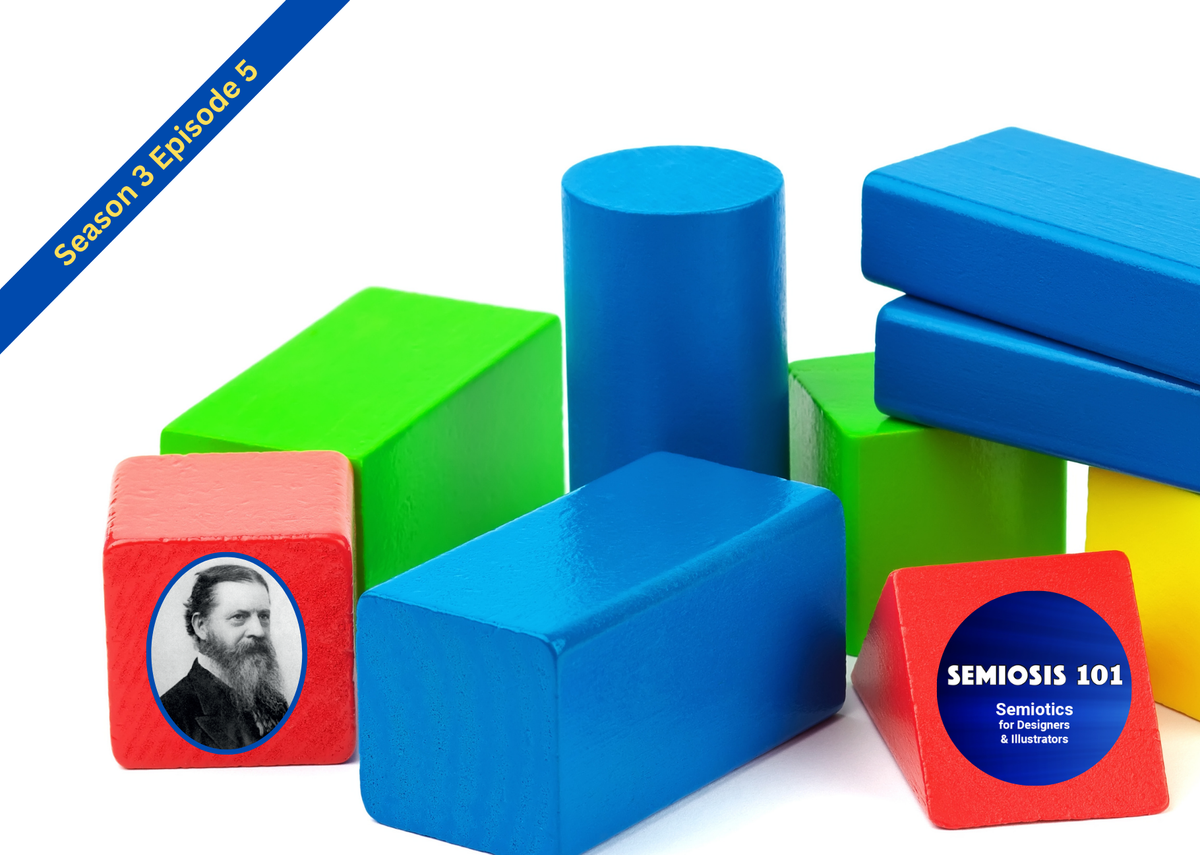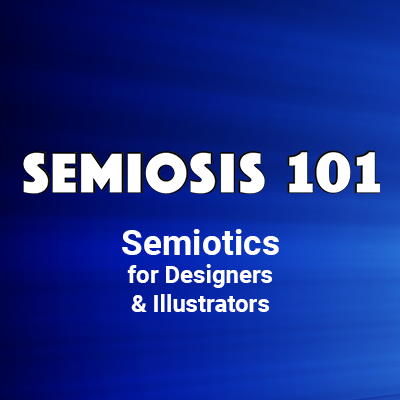Free Semiosis 101 Transcript 3.5:

SEMIOTICALLY BUILDING MEANING: Encoding with Iconic Representation
Hello readers.
In this free transcript for the episode published on Semiosis 101 on Weds 22 Nov 2023, we will explore how Qualisigns and Iconic representation form our basic communicational building blocks. To begin encoding semiotic signs we start with a quality.
Watch the free episode on YouTube for the full impact…
…and here is the episode’s transcript.
So far in this season we have spent four episodes exploring, within Peirce’s pragmatic semiotic theory of Semiosis, how people interpret. This is at the phenomenological level of perception, which unlocks for creatives ways to trigger that perception.
Peirce helps to explain that how at the micro levels of our visual language decisions, a simple line or shape can be meaning-bearing. Each line, shape, colour, mark, etc. used in designing or illustrating can begin to Iconically visually communicate something to someone. This is at the level of qualities, familiarity, resemblances and possibilities. This lowest semiotic sign classification is a Qualisign.
A Qualisign is the first semiotic sign classification out of ten classifications of how meaning is communicated. We will cover these ten signs later in season three, but for now we will explore how Qualisigns and Iconic representation form our basic communicational building blocks.
Hit subscribe to this YouTube channel, and I will explain…
What is there in plain sight but not there, perceptually?
Yes, that is correct. It is a riddle. Everything has a quality - in phenomenological parlance, an essence. We can quantify our world with data. Lengths, widths, depths, mass, weight, height, quotas, etc. But quantifying does not explain the esoteric and existential qualities of lived experiences - of audience’s lifeworlds. We turn to psychology, philosophy …phenomenology to help understand experiences.
We can define the moments of lived experiences, of social encounters, of the daily encountering of the products and things we use emotionally, subjectively and irrationally. We cannot quantify a quality. But as designers and illustrators you are tasked every day to visually communicate to irrational, subjective and emotional humans.You are designing as much for their heart as for their minds.
Peirce’s Qualisign which I have introduced to you, is the first building block in your creative warehouse of building blocks. Together with Iconic representation and the Rhematic possibility of meaning, a Qualisign forms the most simplest of ten semiotic sign classifications. To begin encoding semiotic signs it begins with a quality and nothing more.
Remember Peirce says, “nothing is a sign until interpreted as a sign.” The act of interpretation is triggered by perception. Perception is triggered by these early encoded semiotic levels employing qualities, familiarity, resemblances and possibilities. These qualities are things already known to the target audience from within their lifeworlds. They have in their lived experiences encountered similar qualities.
The possibility of a drawn line being more than itself, rests on its drawn stroke weight and path it takes across the page. A simple line is a simple line, until it is perceived as a possibility its shape is similar to (X) that the audience has experience of. This perception of possible meaning of a simple line as something else is in the subconscious mind of the audience.
Does the line suggest the quality of a tree trunk, an animal’s back, a letter, etc. depends on context. The line is a mere mark but a mere mark that can, to someone, begin to mean something more.
Or not.
Too often creatives believe semiotic signs are something tangible they make and quantify as “that is a semiotic sign.” Too often creatives ignore the fact that everything they design or illustrate has the capacity to visually communicate meaning. Semiosis offers creatives to ensure they enhance visually communicating the intended meaning. Meaning-bearing is shared between the creative and the audience.
Humans are evolutionarily hard-wired to look for meaning in patterns, as our inherited survival early warning system. If the shapes, lines, colours, etc. are the (Iconic) visual communication building blocks within more complex designs or illustrations, then the qualities they attempt to resemble are the subconscious hooks to grab audience attention (Rhematic).
How a shape, line, colour, etc. attempts to suggest a possible meaning through a resemblance in the mind of the audience is crucial (Qualisign).
As I have said already a line is just a line, until it is perceived as something else. You can call this magic, but let us be rational and say it is semiotic sign-action in action. Is the audience’s perception of a simple line as something else correct? Check out episodes 3.1-3.4 for details on the immediate, dynamic and final effects on interpretation.
We covered in these episodes the path of perception, lived experiences and how these can lead perception to interpreting the intended encoded meaning. In visual communication it is easy for designers and illustrators to “just create” what they feel answers the client’s brief.
We have seen in this episode’s introduction an example of visual miscommunication. The visual identity for a business centre using a bold graphic based on the owner’s initials, represents the business in the eyes of the creatives who designed it. But the same graphic also has possible visual qualities shared with a visual representation of a possible figure sitting on a toilet.
This is an extreme case, and a humorous example, but one with serious consequences for the client. The creative, using basic visual communication building blocks creates a graphic that says (X).
Some audience members sees (Z). Then everyone can only see (Z) and not (X). The client needed the audience to focus on (X). The creative never intended to ever put (Z) in the minds of the audience. The creative and client are mortified that anyone could see (X) but interpret (Z). Semiosis and Abductive reasoning/Hypothesis can help creatives to reduce miscommunication.
How?
Well it all begins at the beginning of creativity. The good news is creatives do not have to relearn anything. Applying Semiosis is merely enhancing what creatives already tacitly do during ideation. Semiosis offers a structure to mindfully focus the creation of ideas for answering a client’s brief, one semiotic sign-action at a time.
At the micro level, all designs or illustrations are created from many marks, lines, strokes, shapes, colours, etc. At this level each of these are micro visual communication building blocks. Each block on its own is nothing more than itself. Once composed with another block they offer the potential to be meaning-bearing. At this point this potential may be encoded by the creative to mean the back of an animal or a drop cap on a printed page, etc. It is up to the audience’s perception as to what they interpret.
Any semiotic sign-action will lie dormant in that block until the audience perceive it as suggesting something else. The moment a line is perceived as an animal’s back or the letter “C,” etc. is the moment that semiotics begins to enhance the visual communication. To put in the mind of the audience what the creative, on behalf of the client, intends to communicate begins with Qualisigns. It begins with Iconic representation of familiar qualities to suggest (Rhematic) possible resemblances to things already experienced by the target audience.
These three facets of the determination flow between the concept, its representation and interpretation form into meaning-bearing ephemeral semiotic signs at a subconscious suggestive level. A line is a line. A block is a block. But when placed in connection to each other more complex designed elements emerge. If the audience sees a brick. They see a brick. They also know what walls, houses and buildings are. A brick has the potential to be any of those things. An innocent mark has the potential to become many things, and carry meaning.
Marks, lines, strokes, shapes, colours, etc. individually have a quality. That quality may be nothing more than how they were created. A brush stroke, spilt pool of ink, an off cut shape from another shape, etc. They are NOT semiotic signs.
Marks, lines, strokes, shapes, colours, etc. individually have a quality. That quality may be suggestive to something else other than itself. A brush stroke may suggest a familiarity to a length of hair. An ink blot can suggest the wing of a butterfly. An off cut shape from another shape may suggest an ear, etc. etc. They ARE semiotic signs.
They can become meaning-bearing. They can be perceived as qualities suggesting something else. They can work together to carry meaning of more complex messaging. They are just marks, lines, strokes, shapes, colours, etc. The marks, lines, strokes, shapes, colours, etc. are micro visual communication building blocks to convey meaning beyond themselves.
A stroke of the brush will never convey the Thomas Paine’s Rights of Man tract, but it can be used to suggest qualities of a tree, hair, sunshine, water, etc. It becomes a mental cul-de-sac for creatives to fixate on semiotic signs as tangible things they create.
“Is this a semiotic sign?”
“That must be a semiotic sign?”
Instead, think of encoding semiotic signs as building up visual qualities to possibly become perceivable as meaning something else. Oh! Guess what? This is what designers and illustrators already do.
Semiosis just helps you to do this with more intent to convey the appropriate meaning. In the next episode we will look at semiotically blocking in meaning beyond qualities.
Semiosis 101 Semiotic Design Resources is a reader-supported publication. To receive exclusive posts and support my work, consider becoming a free or paid subscriber. Paid subscribers get name checked on all future Semiosis 101 YouTube episodes.
===Semiosis 101 Patreon Producer==============
Become a Semiosis 101 Patreon Producer and get a named producer credit on future video episodes, plus watch all new episodes months ahead of YouTube.
===Semiosis 101 Patreon Exclusives==============
Watch longer Patreon-exclusive Semiosis 101 episodes on applying Semiosis into design and illustration…
PATEXC001 How does semiotics work in illustration?





